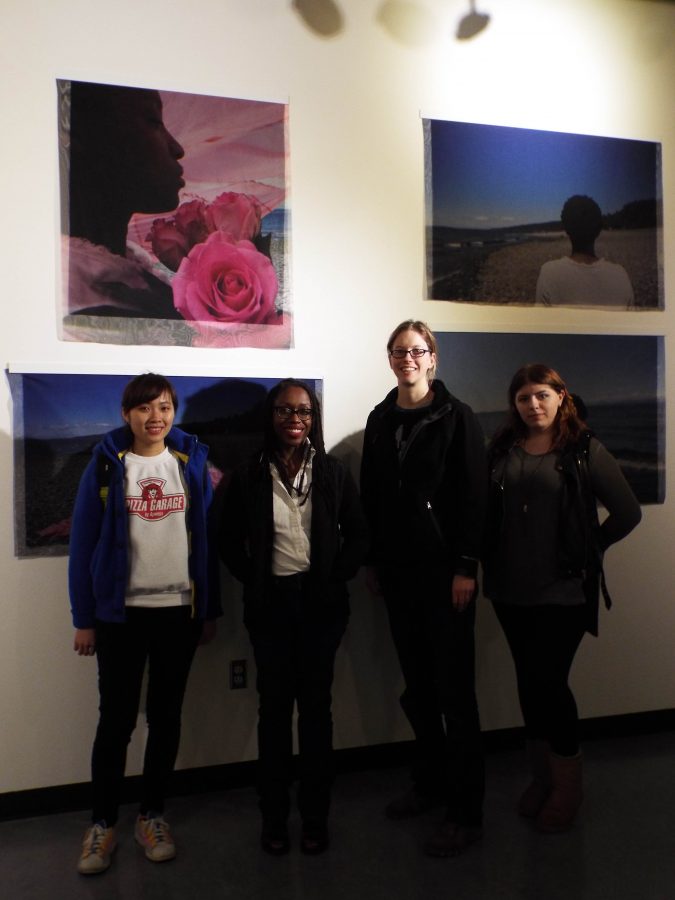Safety, magic and transformation
Seattle artist bridges beauty and discomfort
March 13, 2017
The Art Gallery in Lynnwood Hall honored conceptual artist C Davida Ingram in a reception on Friday, March 3. Ingram’s pieces will be displayed from Jan. 3 to March 13 in an exhibit called “A Work in Progress.”
Live music by the Scarlet Lovers gave the event a touch of class. Redd Gill, a music student at EdCC, accompanied his fiancee Krysta Carson on guitar as she sang Sinatra-style tunes.
Students, faculty and members of the public clapped between songs as they enjoyed attractive appetizers prepared by the college’s catering department.
Heavy Seattle traffic delayed Ingram, and an air of anticipation filled the crowd as they waited.
Running Start student Nick Kasimov pointed to a favorite piece, one of a series called “Lexical Tutor.”
Printed on fluttering fabric, the photograph depicts a black woman seated on a pebbly beach, pink roses clustered in her arms.
Kasimov liked the sheer, pink cloth beneath the subject. “It helps bring out the background,” Kasimov said.
After Ingram arrived, she explained the set of pieces. The beach was at Carkeek Park, the cloth from a pink World War II parachute and the subject was a friend and engineer. Ingram often portrays women from her community in her pieces.
“When you put black figures in a space, you transform it,” she said. “They become something otherworldly, magical.”
Mythology and history are evident in Ingram’s work. She explored the “excess of conjecture” that black women face. Pieces featuring mermaids and dreamers are framed in poems and pictures, symbolic of expectations, perceptions and histories viewers place on black women. Those external pressures drove Ingram to create “a space to dialogue with yourself.”
The saturated hues and natural beauties of “Lexical Tutor” contrasted with a provocative work, titled “Where Can My Black Ass Go to Be Safe?”
“I alternate between what’s hard to look at, and what’s beautiful to look at,” Ingram explained. Being black, identifying as female and queer, Ingram said she has grown comfortable with discomfort.
“Where Can My Black Ass Go to Be Safe?” exemplifies that discomfort. Ingram posed with her backside to the camera, bent over and wearing only lime-green underwear.
Rows of photographs of her rear at different angles stack across four framed pictures.
Speculative answers on the question of safety run in small print between each row.
The most uncomfortable part of the project wasn’t being photographed in a vulnerable position, Ingram said. It was “furnishing answers to that question.”
She asked women of various colors and sexualities where she could go to be safe, and discovered only black women could imagine possible scenarios. After the piece presents the question to the viewer, the small print beckons them to look closer and search for varied, creative answers.
“When she remembers she has overcome terror each time it knocked,” one line reads. Another, “When she can explain the sound of her soul in fluent Caucasian.”
Student Lorenzo Townsend said he chuckled when he first saw the piece. He said as a black person, “That’s what you think about your whole life.” Asked if he thought progress had been made in that area, Townsend said, “I used to think so,” adding that with current events, it was just “an illusion of progress.”
Ingram spoke in a quiet, thoughtful voice, her words carrying in the brightly lit, tall gallery. She characterized her work as experimental and in the black diaspora tradition. Although her pieces explore race and gender, Ingram aims to do so without framing her motives as such.
Her art spans multiple media – including Craigslist ads and photographs – and her themes speak to a wide audience, the objectified, threatened, lost and misunderstood. Ingram imbues a sense of positivity and empowerment in every piece.
The gallery will feature a student spring showcase next quarter. Minh Carrico, a Visual Arts co-department head and faculty member, expects the exhibit to include work from 50-60 students.

